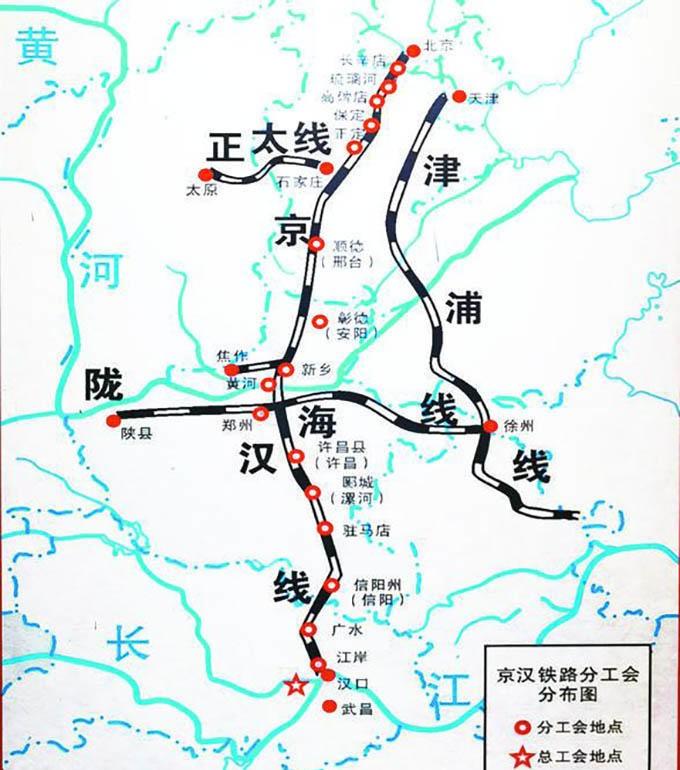When it comes to the railway business of the Qing government, we cannot fail to mention the Beijing-Hankou Railway.
The predecessor of the Beijing-Hankou Railway is the Luhan Railway, which is the Lugou Bridge, han is the Hankou, and the Luhan Railway connects Beijing and Hankou, which is the first railway that the Qing government is ready to build after the Sino-Japanese War.

In fact, the Qing government did not rely entirely on its own strength, after all, the money for the construction of the railway was borrowed from Belgium. On April 1, 1906, after the luhan railway was fully opened, it was renamed the Beijing-Hankou Railway.
The first major artery connecting the north and south of China runs through this. Therefore, this Luján Railway is still worth mentioning.
There are many stations along the Beijing-Hankou Railway, including as many as 15 first-class stations in the Republic of China period. The 15 sites later developed into cities of varying sizes and were once said to be.
Among them, Shijiazhuang and Zhengzhou are naturally indispensable. This is how the opportunity for the development of these two large cities with tens of millions of people began.
The construction of the Luján Railway was first proposed by Jang-jo-dong. Zhang Zhidong believes that the benefits of the railway are the greatest, with the use of local goods and people's livelihood as the greatest, and conscription and transfer of salaries are secondary, and it is very necessary to build a trunk railway.
At that time, Beijing was the political center of the Qing court, and Hankou was a well-known transportation town with a developed industrial base. Everyone sees the benefits of connecting the two places. Zhang Zhidong's performance please be granted.
Since the Luhan Railway was an unprecedented attempt by the Qing government, the imperial court decided to build it in a north-south section. The northern section was presided over by the Viceroy of Zhili and the southern section was presided over by the Viceroy of Huguang. In this context, Zhang Zhidong transferred the governor of Huguang. In order to meet the steel rails needed for construction, Zhang Zhidong even organized the Hanyang Iron Works.
Zhang Zhidong was still relatively far-sighted, and as early as when he initiated the petition, he designed the main route of the railway:
The railway should be taken from Baoding, Zhengding, Cizhou, Lizhang Weihuai and other provinces, the north bank is in the south of Qinghua Town, the south bank is above Xingzekou, and the narrow bank of the upper reaches of the Yellow River is selected to make a bridge to cross the river. Then the three Jin Dynasties are under the Jingxing, the Guanlong is handed over to Luokou, and the northwest sound can be passed.
Zhengding here is now part of Shijiazhuang. "The place where the narrow bank of the upper reaches of the Yellow River does not change" is actually the Xingzekou in the northern suburbs of Zhengzhou. With Luoyang in the west of Zhengzhou and Kaifeng with the Yellow River suspended in the air in the east, they are not the best choice for building the Yellow River Bridge.
The location of the Beijing-Hankou Railway in the northern section was thus laid out. Shijiazhuang and Zhengzhou thus began. It should be known that the predecessors of these two cities are not very good.
Shijiazhuang was only a small village in the Ming and Qing dynasties, with an area of less than half a square kilometer, with only more than 100 households and more than 600 people.
Zhengzhou has a long history, with five times in history as the capital and the Eight Dynasties as a state. However, this is a long time ago, and it is mostly a local regime. At the end of the Qing Dynasty and the beginning of the People's Republic, it was changed from a prefecture to a county. This is the reason why everyone unanimously ridiculed Zhengzhou as Zheng County.
However, the Beijing-Hankou Railway came, and everything changed.
In 1903, Shijiazhuang Railway Station was built and named Zhentou Station. In 1905, the Zhengzhou Yellow River Bridge was completed, and Zhengzhou became an important station of the Beijing-Hankou Railway. Since then, a large number of logistics and people have continuously passed through the two places, passing through the north and south.
The Beijing-Hankou Railway is just the beginning.
In 1907, the Zhengtai Railway was completed and opened to traffic, intersecting with the Beijing-Hankou Railway in Shijiazhuang, and the transportation network system of Shijiazhuang was about to come out.
The Biluo Railway, which was completed and opened to traffic in 1909, followed, and later expanded to the east and west to become the Trans-China Longhai Railway. Beijing, Han and Longhai intersect here, zhengzhou has become a veritable railway center, and the road to a century-old rise has begun.
The railway continued to pool resources to promote the two cities to carry out round after round of urbanization process, and it was only natural that the two cities replaced Baoding and Kaifeng as provincial capitals.